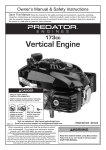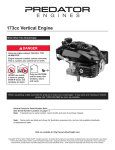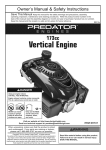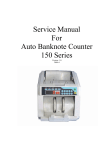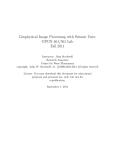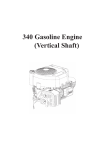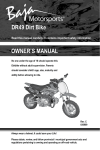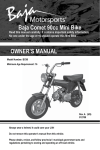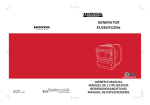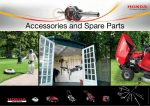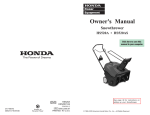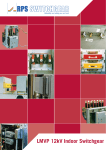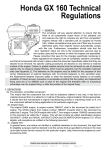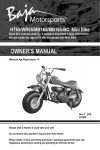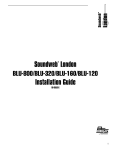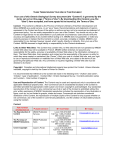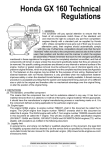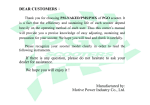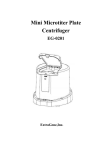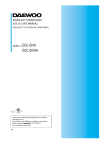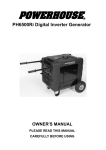Download Owner`s Manual - This website is under maintenance
Transcript
140 160 170 200 Gasoline Engine (Vertical Shaft) Owner’s Manual PREFACE Thank you for choosing a small general gasoline engine of our company. The manual gives information with respect to operation and maintenance of the 140 160 170 200general gasoline engine, and be sure to read it carefully first before operation. Only operate as the manual tells, can insure user’s safety and get the best results of the engine operation. If a problem should arise or if you have any questions about your gasoline engine, consult an authorized our company servicing dealer. The vertical shaft gasoline engine series products in this Owner's Manual are mainly used for the high pressure washer, lawn mower and mini tiller. All information and diagrams of this manual are in accordance with the newest products at the publishing time. If revision and other change of the information descried in this manual are a little different from the actual status, our company will explain it. Our company reserves the right to make change at any time without notice and without incurring any obligation. No part of this publication may be reproduced without written permission. This manual should be considered a permanent part of the generator and should remain with the generator if resold. ·1· SAFETY MESSAGES Your safety and the safety of others are very important. We have provided important safety messages in this manual and on the gasoline engine. Please read these messages carefully. A safety message alerts you to potential hazards that could hurt you or others. Each safety message is preceded by a safety alert symbol and one of three words: DANGER, WARNING, or CAUTION. These mean: You WILL be KILLED or SERIOUSLY HURT if you don’t follow instructions. You CAN be HURT if you don’t follow instructions. Your gasoline engine or other property could be damaged if you don’t follow instructions. ·2· CONTENTS CONTENTS PREFACE… …………………………………………………………… 1 SAFETY MESSAGES… ……………………………………………… 2 I. SAFETY PRECAUTIONS…………………………………………… 4 II. PARTS DESCRIPTION……………………………………………… 6 III. PRE-OPERATE INSPECTION…………………………………… 10 IV. STARTING THE ENGINE… …………………………………… 15 V. RUNNING THE ENGINE………………………………………… 18 VI. STOPPING THE ENGINE… …………………………………… 19 VII. EXHAUST CONTROL SYSTEM SERVICE… ………………………… 20 VIII. MAINTENANCE… …………………………………………… 22 IX. TRANSPORT AND STORAGE… ……………………………… 26 X. TROUBLESHOOTING…………………………………………… 27 XI. SPECIFICATIONS… …………………………………………… 31 XII. ELECTRIC DIAGRAM… ……………………………………… 32 XIII. EASY WORN PARTS AND ACCESSORIES LIST…………………………… 33 ·3· SAFETY PRECAUTIONS I. SAFETY PRECAUTIONS Indicate a possibility of invalid warranty and personal or equipment damage if instructions are not followed. Please pay special attention to the following: 1. Strictly set the engine according to the regulated power on the owner's manual. Do not overload, overrun the engine or run it with low load and at low speed in a long time. 2. Use specified grade of gasoline. The fuel should be fully deposited and filtrated before use. Keep clean the fuel filler, change the oil periodically. 3. Periodically check the installation, connection and the degree of tightness of the fixed bolt. Tighten it if necessary. 4. Periodically clean the element of the air cleaner, change it when necessary. 5. The engine is air-cooled, so clean the radiator, wind cover and fan in time in order to make the engine cool normally. 6. The operator should be familiar with the working principle and structure of the gasoline engine, knowing how to make an emergent stop and the operation of all controlling parts. Any one without training is forbidden to operate the engine. Keep periodical maintenance. Solve problems in time. Do not run the engine in spite of malfunction. 7. Running the engine in a well-ventilated place, keep it at least one meter away from building walls or other equipments, keep away from inflammables such as gasoline, matches and so on to avoid possibility of fire. 8. Refuel in a well-ventilated area with the engine stopped, and in places ·4· SAFETY PRECAUTIONS refueling or storing gasoline, no smoking and any flames or sparks. 9. Refuel the fuel tank not too full so as to avoid fuel’s spilling out. If there is spilled fuel around, be sure to clean it thoroughly before starting. 10. Do not run the engine in airtight or ill-ventilated places. 11. The exhaust muffler is very hot during running the engine even after the engine stops. Never touch it, or you may get burns. Transport or store the engine with it cooling down entirely. 12. Safe warning label: Please carefully read warning label before operating. Our company will not assume any responsibility for person hurt, or equipment damaged caused by disregarding this warning label. Please read the owner’s manual carefully before operating Don’t breath exhaust in Please keep the fire far away Don’t operate indoors. 13. Exhaust label: ·5· II. PARTS DESCRIPTION 1. Feature CARBURETOR OIL DIPSTICK SPARK PLUG MUFFLER STARTER GRIP FUEL TANK CAP FUEL TANK AIR CLEANER (140) ·6· PARTS DESCRIPTION START HANDLE OIL DIPSTICK MUFFLER SPARK PLUG FUEL TANK COVER AIR CLEANER (160 170) ·7· PARTS DESCRIPTION START HANDLE OIL DIPSTICK SPARK PLUG MUFFLER FUEL TANK COVER AIR CLEANER (200) ·8· PARTS DESCRIPTION 2. Model No. MODEL NO. FINISHED PRODUCT NO. SER. NO. (140 160 170) MODEL NO. FINISHED PRODUCT NO. SER. NO. (200) ·9· PRE-OPERATE INSPECTION III. PRE-OPERATE INSPECTION 1. Engine Oil Engine oil is a key factor in deciding the engine’s performance. Do not apply engine oil with additives or 2-stroke gasoline engine oil, because they haven’t enough lubrication, and may shorten the engines service life. Check the engine with it stopped on a level ground. Engine oil capacity: 140 0.5L 160 170 200 0.6L Engine oil recommended: SAE10W-30 As viscosity varies with regions and temperatures, SF class oil is recommended. Check method: 1) Remove the dipstick and clean it. 2) Reinsert the dipstick into the oil Filling hole without screwing it, and check oil level. 3) If the oil level is too low, add the recommended engine oil up to the oil upper level. 4) Reinstall the dipstick. · 10 · PRE-OPERATE INSPECTION Engine oil change: Used engine oil may cause skin cancer if repeatedly left in contact with the skin for prolonged periods. It is still advisable to thoroughly wash your hands with soap and water as soon as possible after handling used oil. Please dispose of used engine oil in a manner that is compatible with the environment. OIL DIPSTICK OIL HOLE 1) Screw the oil dipstick out. 2) Tilt the gasoline engine and let the oil overflowing out from the hole. · 11 · PRE-OPERATE INSPECTION 2. Air Cleaner Never run the engine without an air cleaner, or severe wear of the engine may be resulted in. AIR CLEANER ELEMENT AIR CLEANER COVER 1) Remove the air cleaner housing. 2) Remove foam element or paper element, paying attention to prevent dust and foreign matter entering into air cleaner. 3) Check, clean or replace damaged air cleaner parts. 4) Reinstall the air cleaner parts back. FUEL UPPER LEVEL FUEL 3. Fuel Check 1) Remove the fuel tank cap and check fuel level. 2) If the level is too low, refuel the tank. Remember adding fuel not over the fuel upper level. · 12 · FUEL TANK PRE-OPERATE INSPECTION 1. Gasoline is extremely flammable and is explosive under certain conditions. 2. Refueling in a well-ventilation area with the engine stopped. Do not smoke and allow flames or sparks in the area where gasoline is stored or where the fuel tank is refueled. 3. Do not overfill the fuel tank (there should be no fuel in the filling neck). After refueling, make sure the fuel tank cap is set back securely. 4. Be careful not to spill fuel when refueling. Spilled fuel or fuel vapor may ignite. If any fuel is spilled, make sure the area is dry before starting the engine. 5. Avoid repeated or prolonged contact with skin or breathing of fuel vapor. Keep out of reach of children. Fuel tank capacity: 1.0L Only use unleaded gasoline and recommend gasoline grade 90#over. Unleaded gasoline can reduce gasoline engine carbon deposit and prolong the exhaust system service life. Never use contaminated gasoline or mixed gasoline with oil. Don’t allow the dust, foreign matter or water entering into fuel tank. Fuel may damage the oil paint and plastic. Be careful not to spill fuel when refueling. Any damage due to oil spilling is not within valid warranty. · 13 · PRE-OPERATE INSPECTION "Light knocking" or "spark exploding" sound can be hear when the engine overloading. It is normal. Do not worry about that. If " knocking" or "spark exploding" sound occur at a steady speed under normal load, change brand of gasoline; if such phenomena still happen, consult your dealer for help, otherwise the engine may be damaged. When the engine is running, continuously "Knocking" or "spark exploding" sound occurring will damage engine. "Knocking" or "spark exploding" sound from misusing will not be within the valid warranty. · 14 · STARTING THE ENGINE IV. STARTING THE ENGINE 1. Starting method: A. Turn the throttle lever and brake lever along with direction of arrow to bottom. (“OPEN” position), As shown as following. BRAKE LEVER THROTTLE LEVER CLOSE OPEN B. Turn the throttle lever along with direction of arrow to bottom. (“OPEN” position) and turn the engine stop switch to “ON” state as shown as following. STOP ENGINE SWITCH (ON) THROTTLE LEVER CLOSE STO P OPEN · 15 · STARTING THE ENGINE C. Put the choke cable to “OPEN” position and turn the engine stop switch turn to “ON” position at the same time as shown on the following drawing: CHOKE CABLE STOP ENGINE SWITCH (ON) OPEN STO P Don’t pull the throttle level if the gasoline engine is hot. Assemble the choke cable according to user requirement. D. Starting primer gasbag operation is important operation of the starting engine. Turn the stop engine switch to “ON” state. For cold starting, slightly press the primer gasbag three to five times in succession and quickly pull the recoil cable grip. For hot starting, directly pull the starter cable grip. STOP ENGINE SWITCH (ON) PRESS GASBAG THREE TIME. THEN, PULL CABLE GRIP. START ENGINE · 16 · STO P STARTING THE ENGINE 2. STARTING THE ENGINE Pull the starter grip lightly until resistance is felt, then, briskly pull to syncline upper 30 degree out. Don’t allow the starter grip to snap back against the engine. Return it gently to prevent damage to the starter · 17 · RUNNING THE ENGINE V. RUNNING THE ENGINE 1. After starting, push the choke lever in the direction of the arrow to bottom. 2. After preheating the engine a period of time, you can fix a load. AIR CLEANER START IDLE RUNNING 3. Pull the choke cable from the "OPEN" position to "RUNNING" position after starting engine. 4. Change the engine speed by adjusting the governor screw. For high speed, turn clockwise, and for low speed, turn counterclockwise. Please operate carefully. If you have any question, please contact our company authorized dealer unless the user have the proper tool and professional ability. · 18 · STOPPING THE ENGINE VI. STOPPING THE ENGINE 1. Slowly turn the throttle lever to “IDLE” position AIR CLEANER START IDLE RUNNING 2. If the engine is controlled by brake lever, only turn the brake lever to “CLOSE” position for stopping engine ( as shown on the following Fig.1) If the engine is controlled by engine stop switch, For stopping the engine, directly turn the stop engine switch to "0" position (as shown on the following Fig.2) or press down the "STOP" for 5 seconds over by first finger, then loosen it (as shown on the following Fig.3). The engine stop engine is device of the opening and closing ignition circuit. (as shown on the following Fig.2) ENGINE STOP SWITCH ON OFF THROTTLE LEVER CLOSE OPEN (Fig.1) (Fig.2) (Fig.3) Sudden stopping at high speed under heavy load is forbidden, otherwise damage will result. · 19 · EXHAUST CONTROL SYSTEM SERVICE VII. EXHAUST CONTROL SYSTEM SERVICE With the engine running, carbon monoxide, oxide of nitrogen and hydrocarbon will produce, and in certain conditions, oxide of nitrogen and hydrocarbon will react chemically each other to make smoke while carbon monoxide is toxic, so exhaust control of them is very important. The company decreases the exhaust emissions by introducing poor-fuel carburetors and other devices into the engine to solve the problem. To keep the exhaust of your engine with in the standard exhaust emission, pay attention to the following: 1. Maintenance Maintain the engine periodically in accordance with the maintenance schedule in the manual. The maintenance schedule is made out on the base of normal use in normal conditions, if using under heavy load, dusty or wet circumstances or in high temperature, service of the engine should be done more often. 2. Replacing Parts To ensure the best quality and reliability, use only new genuine our company parts or their equivalents for repair and replacement. 3. Tampering and Altering Tampering with or altering the emission control system may increase emissions beyond the legal limit. Among those acts that constitute tampering are: 1) Removal or alteration of any part of the intake, fuel, or exhaust systems. · 20 · EXHAUST CONTROL SYSTEM SERVICE 2) Altering or defeating the governor linkage or speed-adjusting mechanism to cause the engine to operate outside its design parameters. 4. Problems Affecting Exhaust Emissions 1) Difficult starting or difficult stopping. 2) Unstable idle speed. 3) Give off black smoke or consume too much fuel. 4) Poor ignition sparks or sparks returned. 5) Too early ignition. · 21 · MAINTENANCE VIII. MAINTENANCE 1. Maintenance Schedule In order to keep the engine well, must periodically service and adjust the engine. Service shall be as following schedule. MAINTENANCE SCHEDULE Frequency Item Oil level check Engine oil Each time Check Clean – replace Clean, adjust Spark plug Each season or 50 hrs Every 6 month or 100 hrs Each year or 300 hrs √ Replace Air cleaner First month or 20 hrs √ √ √ √ √ Replace √ Oil strainer Clean √ Valve clearance Checkadjust √* Cylinder head Clean √* Fuel tank Replace Every three years * These items should be serviced by company authorized dealer, unless you have the proper tools and mechanically proficient. Service more frequently when used in dusty areas. · 22 · MAINTENANCE 2. Maintenance Method 1) Replacement of engine oil Drain the engine oil rapidly and completely out when the engine is hot. (1) Remove the oil dipstick, drain plug and washer and drain engine oil thoroughly. Reinstall the drain plug and screw in it securely. (2) Fill the recommended engine oil and check oil level with oil dipstick. (3) Reinstall the oil dipstick and tighten it securely. Please dispose of used engine oil and the oil containers in a manner that is compatible with the environment. We suggest you take used oil in a sealed container to your local recycling center or service station for reclamation. Do not throw it in the trash or pour it on the ground or down a drain. 2) Maintenance of air cleaner A dirty or damaged air cleaner will allow dust entering into the engine, causing rapid engine wear. So, service the air cleaner in time. . Remove the bolt and air cleaner cover. Be careful to prevent dirt and debris from falling into the air cleaner base opening. . Remove the foam element or paper element. . Check, clean or replace the damaged air cleaner parts. . Reinstall the air cleaner parts, then bolt and screw down it. · 23 · MAINTENANCE Never clean the air cleaner element with gasoline or low flash-point detergents, or explosion may happen. Clean the foam filter with soapy water, blow the paper element with compressed air or lightly tap off dust and never dry to brush . (1) Gasoline is extremely flammable and explosive in certain condition. Keep cigarette, sparks and fire away. (2) After reinstalling the deposit cup, don’t start the engine until the area around is dry. 3) Maintenance of spark plug In order to ensure the engine normal running, gap of the spark plug must be correct and no deposit around the spark plug. 0.7-0.8mm Spark recommended using plug model NGK: BP6ES/BPR6ES DENSO: W16EPR-U/W16EP-U CHAMPION: RN9YC4 NHSP: F7TC/F7RTC TORCH: F7TC/F7RTC Don’t touch the muffler to avoid burn in the engine running or just stopping a moment. · 24 · MAINTENANCE (1) Remove the spark plug cap. (2) Clear away dirt around the spark plug base. (3) Dismantle the spark plug with a spark plug wrench. (4) Visually check the spark plug. Clean with a steel brush. If the insulator is damaged, replace the spark plug instead. (5) Measure the spark plug clearance with a feeler. The clearance should be 0.7~0.8mm. If adjustment is necessary, bend the side electrode carefully. (6) To avoid cross-threading, first, screw in spark plug by hand, then tighten with a spark plug wrench to compress the gasket. (7) If a new spark plug is used, please replace it with same spark plug model as can as possible, and more twist 1/2 turns after compressing the gasket. (8) If reinstalling the used spark plug, just more twist 1/8-1/4 turns. (1) The spark plug must be tightened securely, or it may become very hot to damage the engine. (2) Only use recommended spark plug or the equivalent. Incorrect heat range of the spark plug may damage the engine. 4) Idle speed adjustment of the carburetor . (1) Start the engine and preheat it to normal operating temperature. . (2) Adjust the throttle stopping screw to obtain minimum idle speed. Minimum idle speed:(1,900±100) r/min. · 25 · TRANSPORT AND STORAGE IX. TRANSPORT AND STORAGE Do not incline the engine so as to avoid fuel’s spill in transporting. Spilled fuel or fuel vapor may ignite to cause fire. If suspension for a long time, storage should be as following: 1. The storage area is dry and free of dust. 2. Completely drain fuel out of the fuel tank and carburetor. Fuel is extremely flammable and explosive under certain conditions. Keep smoke, fire and spark away from operating site. 3. Replace engine oil. 4. Remove the spark plug. Fill about a spoon of fresh engine oil onto the cylinder. Crank the engine up to distribute engine oil evenly. Reinstall the spark plug. 5. Lightly pull the recoil starter rope until the resistance is felt. Close the choke to protect the dust from entering in. 6. Cover the engine to protect dust entering. · 26 · TROUBLESHOOTING X. TROUBLESHOOTING 1. Start Engine Difficultly (By using recoil starter) Fuel supply is not smooth or no fuel supply. Fuel supply is normal. Spark plug is in bad conditions Normal spark plug Something wrong with the fuel system. Normal high – tension line spark. High-tension line no spark High-tension coil run out Normal ignition system. Normal spark plug spark Normal fuel supply system. Normal fuel supply system. Abnormal cylinder compression. Normal cylinder compression TROUBLE CAUSE There is no enough fuel in fuel tank and fuel cock is closed. Air vent in the fuel filler cap is clogged Fuel cock is clogged Improper or clogged main oil flow hole. Needle valve is not closed properly or start hole is clogged. Float is damaged or sticking. Fuel is too filthy or deteriorated There is water in fuel. Too much fuel in engine Wrong fuel brand Too much carbon deposit and dirt around electrodes. Electrodes are burn damaged seriously or insulators damaged. Improper electrodes gap. High –tension line is damaged. Ignition coil is damaged. REMEDY Fill fuel, open fuel cock. Dredge air vent. Clean first and then dredge Readjust or clean, blow to get through. Dismantle needle valve and repair, clean, blow to get through. Repair float Replace Replace Drain extra fuel, dry up spark plug electrodes. Select proper fuel brand corresponding with the requirements. Clear away. Replace spark plug. Adjust to proper value. Replace Replace Magneto loses magnetism. Replace Wrong gap between ignition Adjust gap between ignition and coil and flywheel flywheel Piston ring is worn to or even Replace over its wear limit Piston ring is broken. Replace Piston ring is sticking. Clear up carbon fouling. Spark plug is not installed Tighten with a gasket in. tighten or without a gasket. Check cylinder gasket, and the flatness of the surface by Air leakage between cylinder which cylinder block contactblock and cylinder head. ing with cylinder head Tighten cylinder head bolts in stipulated order to stipulated torque. Check valve. Clearance and Air leakage in the valves tightness, repair if necessary. · 27 · TROUBLESHOOTING If still can’t starting, have the engine to our authorized dealer for repairing. · When testing the spark plug, never hold the high- voltage wire of the spark plug with wet hand. · Make sure there is no spilled fuel outside the engine and that the spark plug isn’t dipped with fuel. · To prevent fire, keep sparks far away from the spark plug mounting hole. 2. Gasoling Engine Power Output Insufficiency Fuel supply system CAUSE Poor compression When increasing throttle, speed increase slow or even decrease and stop running TROUBLE Air in fuel line or fuel line clogged Main oil flow hole is not adjusted properly In carburetor, needle valve hole and main oil flow hole clogged. Fuel cock is clogged up. Exhaust air or dredge fuel line Readjust Clean and blow to get through Clean, replace damaged part Too much carbon deposit in Clear away combusting chamber. Too much car bon fouling in Clear away muffler and exhaust pipe. Clean air cleaner filter eleAir cleaner is clogged up. ment Intake pipe is leaking Repair or replace Piston or cylinder or piston ring Replace the worn is worn Air leakage from the surface by which cylinder block contacting Replace cylinder gasket with cylinder head. Too big or too small valve clearReadjust ance. Valve tightness is poor. · 28 · REMEDY Repair TROUBLESHOOTING 3. Gasoline Engine Gannot Running Unsmoothly TROUBLE CAUSE Knocking sound Abnormal combustion Spark lacking Piston, cylinder or piston ring is worn excessively. Piston pin and piston pin hole are worn excessively. Tie rod small head is worn excessively. Roller bearing for crankshaft main shaft is worn. Engine is too hot Too much carbon deposit in combustion chamber Improper gasoline brand or low gasoline quality There is water in float chamber improper spark plug electrodes clearance Something wrong with induced coil, and so on REMEDY Replace the worn Replace piston or piston pin Replace tie rod Replace roller bearing Shoot trouble Clear away Replace with qualified gasoline Clean Adjust Check and replace damaged parts 4. Stop Suddenly When Running TROUBLE CAUSE Fuel supply system Stop suddenly when running. Ignition system The other Fuel is finished Carburetor is clogged Float chamber is leaking Needle valve is sticked. Spark plug is punctured, or short-circuited by carbon deposit Side electrode of spark plug is dropped out High-tension wire is dropped out Ignition coil is punctured or short-circuited Parking wire is located on engine body Cylinder is seriously scored and valve dropped out REMEDY Refill fuel Check fuel line and dredge Repair Dismantle float chamber and eliminate it Replace spark plug Replace spark plug Weld on Replace ignition coil Find out meeting and insulate Repair or replace damaged parts · 29 · TROUBLESHOOTING 5. Gasoline Engine Is Overheat TROUBLE Gasoline engine is overheat CAUSE Oil insufficient or wrong oil ratio in the gasoline Exhaust pipe blocked up Shroud leaking Cooling fins blocked by foreign matter Connection rod deformation to make piston and cylinder bushing side wear Cylinder or piston or piston ring is worn to make hunting between cylinder and crankcase Improper adjustment of engine governor to produce speed high. Crankshaft main bearing burnt out REMEDY Refill engine oil Clean exhaust pipe Repair damaged part Clear cooling fins Replace connection rod Replace the worn parts Readjust engine governor Replace main bearing The gasoline engine should be kept about 80 ~ 110℃ temperature around the outlet of the shroud. If the temperature is too high, it will indicate the gasoline engine overheating. 6. Abnormal Noise Exist When Engine Running TROUBLE Beating sound CAUSE REMEDY Piston, piston ring or cylinder is worn Connection rod or piston pin and piston pin hole are worn Crankshaft main neck is worn Replace the worn part Replace the worn part Replace bearing Piston ring is broken Replace piston ring Too much carbon deposit in combust- Clear away carbon Metal b eatin g ing chamber deposit sound when abImproper fuel brand Replace fuel normal combusFind a cause and Engine is overheat tion occurs eliminate it Readjust valve Improper valve clearance clearance properly The other Fly wheel is not connected with crankConnect tightly shaft tightly · 30 · SPECIFICATIONS XI. SPECIFICATIONS 1. Main Specificaton Model items L×W×H(not including crankshaft output terminal)(mm) Dry Weight(kg) 140 160 365×291×275 10 170 395×348×282 12.1 Engine Type 200 404 x 356 x 292 12.5 13 single cylinder horizontal,4-stroke, (OHV) Displacement(ml) 139.36 163 173.2 196.2 Bore × Stroke(mm) 65×42 68×45 70×45 70×51 Theoretical Maximum Power 2.3kw/3,600r/min 3.0kw/3,600r/min 3.2 kw/3,600r/min Recommended Using 1.5kw/3,000r/min 2.3kw/3,000r/min 2.4kw/3,000r/min Power Maximum Torque 6.3N·m/2,500r/min 8.8N·m/2,500r/min 9.0N·m/2,500r/min Fuel Consumption 3.5kw/3600r/min 2.5kw/3000r/min 10.5N•m/2500r/min 395g/kw·h Cooling System Forced air Ignition System capacitance discharge type PTO Shaft Rotation vertical shaft output Data Adjustment Items Spark plug clearance Carburetor idle speed Valve clearance (cold engine) Technical data 0.7-0.8mm 1900±100r/min intake: 0.15±0.02mm exhaust: 0.20±0.02mm Service To see P23 To see P24 Serviced by our company authorized dealer Specification is subject to change without notice. For further information, please contact our company dealer. 2. Torque Of Important Bolts Items Connection-rod bolt Cylinder head bolt Flywheel nut Crankcase cover bolt Valve clearance adjusting nut Valve rocker bolt Specifications M7×1.25 M8×1.5 M14×1.5 M8×1.5 M6×0.5 M8×1.25 Torque valve N·m kg·m 12 1.2 26 2.6 52 5.2 26 2.6 10 1.0 24 2.4 · 31 · ELECTRIC DIAGRAM XII. ELECTRIC DIAGRAM ENG SWITCH ENG SWITCH OFF ON SPARK PLUG · 32 · IGNITION COIL B1 Black EASY WORN PARTS AND ACCESSORIES LIST XIII. EASY WORN PARTS AND ACCESSORIES LIST Easy worn parts list: Accessories list: Cylinder head cover gasket Socket Cylinder head gasket Force bar Spark plug Oil sealing Breath groove gasket Crankcase gasket Recoil starter Carburetor gasket Carburetor insulation gasket Insulation plate gasket Air cleaner gasket Exhaust vent gasket · 33 · 93004-Z030430-0000








































